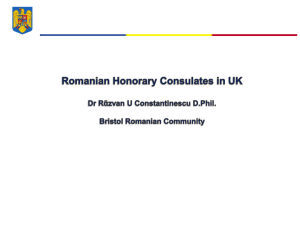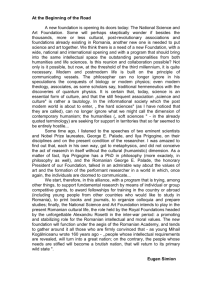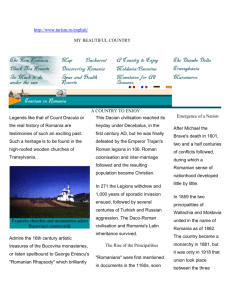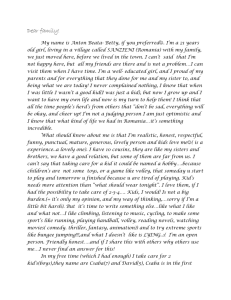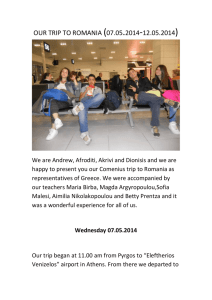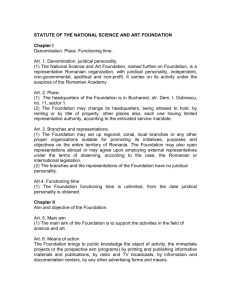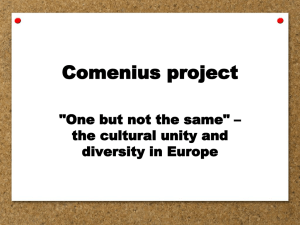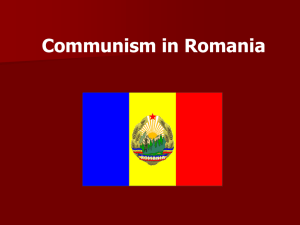sharingBetweenCultures
advertisement
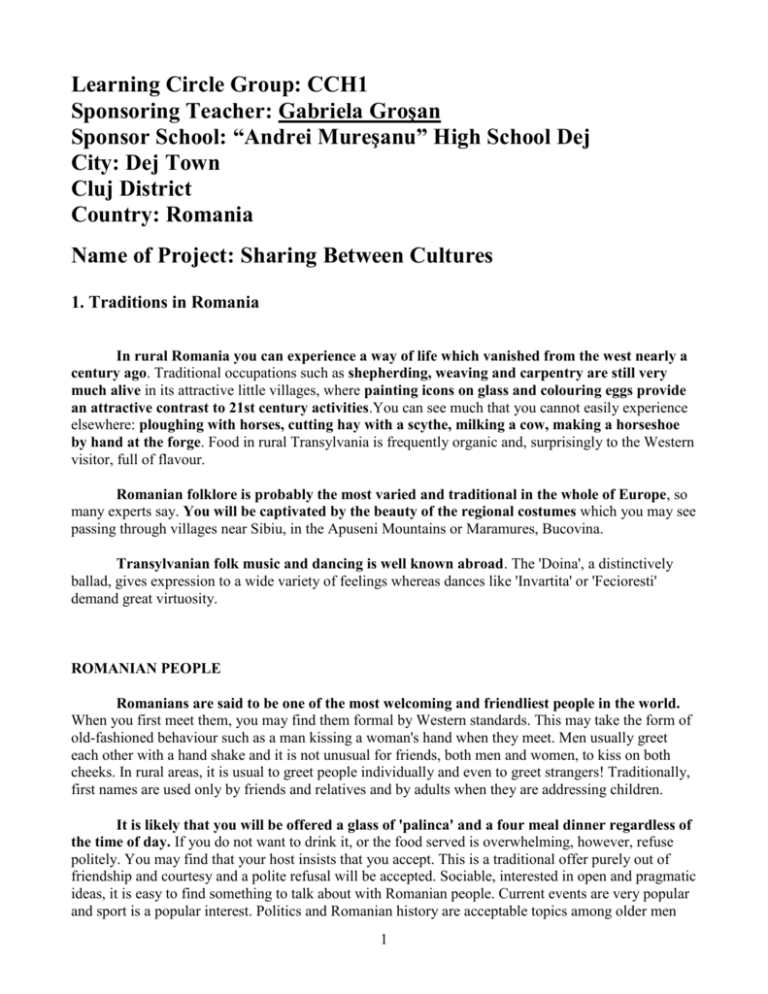
Learning Circle Group: CCH1 Sponsoring Teacher: Gabriela Groşan Sponsor School: “Andrei Mureşanu” High School Dej City: Dej Town Cluj District Country: Romania Name of Project: Sharing Between Cultures 1. Traditions in Romania In rural Romania you can experience a way of life which vanished from the west nearly a century ago. Traditional occupations such as shepherding, weaving and carpentry are still very much alive in its attractive little villages, where painting icons on glass and colouring eggs provide an attractive contrast to 21st century activities.You can see much that you cannot easily experience elsewhere: ploughing with horses, cutting hay with a scythe, milking a cow, making a horseshoe by hand at the forge. Food in rural Transylvania is frequently organic and, surprisingly to the Western visitor, full of flavour. Romanian folklore is probably the most varied and traditional in the whole of Europe, so many experts say. You will be captivated by the beauty of the regional costumes which you may see passing through villages near Sibiu, in the Apuseni Mountains or Maramures, Bucovina. Transylvanian folk music and dancing is well known abroad. The 'Doina', a distinctively ballad, gives expression to a wide variety of feelings whereas dances like 'Invartita' or 'Fecioresti' demand great virtuosity. ROMANIAN PEOPLE Romanians are said to be one of the most welcoming and friendliest people in the world. When you first meet them, you may find them formal by Western standards. This may take the form of old-fashioned behaviour such as a man kissing a woman's hand when they meet. Men usually greet each other with a hand shake and it is not unusual for friends, both men and women, to kiss on both cheeks. In rural areas, it is usual to greet people individually and even to greet strangers! Traditionally, first names are used only by friends and relatives and by adults when they are addressing children. It is likely that you will be offered a glass of 'palinca' and a four meal dinner regardless of the time of day. If you do not want to drink it, or the food served is overwhelming, however, refuse politely. You may find that your host insists that you accept. This is a traditional offer purely out of friendship and courtesy and a polite refusal will be accepted. Sociable, interested in open and pragmatic ideas, it is easy to find something to talk about with Romanian people. Current events are very popular and sport is a popular interest. Politics and Romanian history are acceptable topics among older men 1 and will be hotly debated by them. People will most certainly talk about Ceausescu and communism and many of them will have amazing stories to tell. Romanians are, cheerful, happy people, always ready for guests and celebration. Any shyness will quickly change if you are friendly and interested. You will be surprised at the ability of many Romanians to speak other languages, including English. Should you be invited to the home of a Romanian, you may find that you are the guest of honour or at least the centre of attention. Hosts appreciate it when a dinner guest brings flowers or another gift. Make sure that you stay for a few hours, talk to everyone present and eat as much as you can! 2. Folk and traditional music Romania is a European country with a multicultural music environment which includes active ethnic music scenes. Romania also has thriving scenes in the fields of pop music, hip hop, heavy metal and rock and roll. During the first decade of the 21st century some Europop groups/artists, such as Morandi, Akcent, Edward Maya, Alexandra Stan, Inna and Yarabi, achieved success abroad. Traditional Romanian folk music remains popular, and some folk musicians have come to national (and even international) fame. History Folk music is the oldest form of Romanian musical creation, characterised by great vitality; it is the defining source of the cultured musical creation, both religious and lay. Conservation of Romanian folk music has been aided by a large and enduring audience, and by numerous performers who helped propagate and further develop the folk sound. One of them, Gheorghe Zamfir, is famous throughout the world today, and helped popularize a traditional Romanian folk instrument, the panpipes. The religious musical creation, born under the influence of Byzantine music adjusted to the intonations of the local folk music, saw a period of glory between the 15th-17th centuries, when reputed schools of liturgical music developed within Romanian monasteries. Russian and Western influences brought 2 about the introduction of polyphony in religious music in the 18th century, a genre developed by a series of Romanian composers in the 19th and 20th centuries. Traditional music Banat In Banat, the violin is the most common folk instrument, now played alongside imported woodwind instruments; other instruments include the taragot (today often the saxophone plays the taragot role in bands), which was imported in the 1920s from Hungary. Efta Botoca is among the most renowned violinists from Banat. Bucovina Bucovina is a remote province, and its traditions include some of the most ancient Romanian instruments, including the ţilincă and the cobza. Pipes (fluieraş or fluier mare) are also played, usually with accompaniment by a cobza (more recently, the accordion). Violins and brass instruments have been imported in modern times. Crişana Crişana has an ancient tradition of using violins, often in duos. This format is also found in Transylvania but is an older tradition. Petrică Paşca has recently helped popularize the taragot in the region. Dobrogea Dobrogea's population is especially diverse, and there exist elements of traditional Tartar, Ukrainian, Turkish and Bulgarian music among those populations. The most popular dance from Dobrogea is the geamparale, which is very different from the other traditional dances of Romania. In fact, Dobrujan music is characterized by Balkan and Turkish rhythms. Maramureş and Oaş The typical folk ensemble from Maramureş is zongora and violin, often with drums. Taragot, saxophone and accordion have more recently been introduced. In Oaş, a violin adapted to be shriller is used, accompanied by the zongora. The singing in this region is also unique, shrill with archaic melodic elements. Moldavia (Moldova) Violin and cimbalom are the modern format most common in Moldavian dance music. Prior to the 20th century, however, the violin was usually accompanied by the cobza. Brass ensembles are now found in the central part of the county. Among the most renowned violinists from this region is Ion Drăgoi. There are also many musicians among the Csango, ethnic Hungarians who live in the Siret Valley. Moldavia is also known for brass bands similar to those in Serbia. 3 Transylvania Transylvania has been historically and culturally more linked to Central European countries than Southeastern Europe, and its music reflects those influences. Violin, viola and double bass, sometimes with a cimbalom, are the most integral ensemble unit. At the beginning of the 21st century a few bands (such as the Palatka Gypsy Band) still play these traditional instruments, while most bands use newer instruments such as the clarinet or accordion. All these instruments are used to play a wide variety of songs, including numerous kinds of specific wedding songs. Drum, guitar and violin make up the typical band in Maramureş, and virtuoso fiddlers are also popular in the area. In the end of the 1990s, the Maramuzical music festival was organized to draw attention to the indigenous music of the area. Wallachia Wallachia is home to the taraf bands, which are perhaps the best-known expression of Romanian folk culture. Dances associated with tarafs include brâu, geamparale, sârba and hora. The fiddle leads the music, with the cimbalom and double bass accompanying it. The cobza, once widespread in the region, has been largely replaced by the cimbalom. Lyrics are often about heroes like the Haidouks. Taraf de Haidouks is an especially famous taraf, and have achieved international attention since their 1988 debut with the label Ocora. The Haidouks first attained visibility as lăutari, traditional entertainers at weddings and other celebratory occasions. Muntenia Muntenia has a diverse set of instrumentation. The flute (fluier in Romanian) and violin are the traditional melodic element, but now clarinets and accordions are more often used. Accordionists include the renowned performers Vasile Pandelescu and Ilie Udilă. Oltenia Oltenia's folk music and dance is similar to Muntenia. Violins and pipes are used, as are ţambal and guitar, replacing the cobza as the rhythmic backing for tarafs. The cimpoi (bagpipe) is also popular in this region. Doina The most widespread form of Romanian folk music is the doina. There are other styles of folk music. These include the bocet ("lament"), cântec batrânesc (traditional epic ballads; literally "song of the elders") and the când ciobanu şi-a pierdut oile ("when the shepherd has lost the sheep"). Doina is poetic and often melancholic, sometimes compared to the blues for that reason. Doinas are often played with a slow, free rhythm melody against a fast accompaniment pattern in fixed tempo, giving an overall feeling of rhythmic 4 Our classmate Andrei Suteu and two schoolmates dressed in the popular costumes. Folk costumes The structure of Romanian traditional clothing has remained unchanged throughout history and can be traced back to the earliest times. The basic garment for both men and women is a shirt or chemise, which is made from hemp, linen or woollen fabric. This was tied round the waist using a fabric belt, narrow for women and wider for men. The cut of this basic chemise is similar for men and women. In the past those worn by women usually reached to the ankles while men's shirts were shorter and worn over trousers or leggings made from strips of fabric. Women always wear an apron over the chemise. This was initially a single piece of cloth wrapped round the lower part of their bodies and secured by a belt at the waist, as is still seen in the east and south east of Romania. In Transylvania and the south west of Romania this became two separate aprons, one worn at the back and one at the front. Men's traditional clothing throughout Romania comprises a white shirt (cămasă), white trousers, hat, belt, waistcoat and or overcoat. Local differences are indicated by shirt length, type of embroidery, trouser cut, hat shape, or waistcoat decoration. In most areas shirts are worn outside trousers, which is the older style. This is a basic Balkan man's costume largely uninfluenced by fashions from west or east. Hungarian and Saxon men living in Romania wear trousers with a more modern cut often made of dark material rather than white. This reflects their closer ties, and more frequent communication, with the west. 5 The outer garments worn by both men and women are similar, the main differences being in cut and decoration which depend mainly on the region of provenance. These garments are usually made of sheepskin, or felted woollen fabric, and decorated with leather appliqué and silk embroidery. Traditional clothing worn on workdays and festivals used to be similar, the main difference being that the festive dress, especially those worn for weddings was more richly embroidered. In the past the headwear worn by the bride was especially ornate with specific local styles. In poorer areas basic clothing with little or no embroidery has always been worn. The various pieces of costume have gone out of use at different times during the 20th century. The first item to disappear in many areas were leather peasant sandals (opinci), although these could be seen in poorer villages again in the years just after the communist regime fell. In most rural areas men's traditional trousers were replaced by modern factory made trousers by mid century and in the post communism years jeans has become universally common. Traditional over garments became an expensive luxury, new garments only being purchased by people living in the very wealthy villages. More recently the traditional jacket makers in many areas have died with few new artisans being trainer to carry on their craft. However if you look closely in the more remote areas some older people still wear items of traditional clothing. This can be for women a gathered black skirt or dark wraparound with a blouse of local cut either with or without a leather waistcoat. In Oaş and Maramureş even young girls often wear the local fashion costume on Sundays. This is normally made from brightly coloured material, in Oaş a dress, in Maramureş a skirt. Added to the local costume is the latest fashion in blouses and footwear such as white lacy blouses in Maramureş and platform shoes or stilettos, in both regions. Men usually have "western " trousers or jeans but may have a local shirt, or local shaped hat, although unfortunately the universal trilby is fast replacing these. Certain items of costume, specific to occupations, are still worn, for example men working in the forestry industry wear the wide leather belts (chimir), usually now over a T-shirt and jeans. Men's traditional fur hats (caliciulă) are still worn in winter in rural areas, and women usually wear a printed woollen scarf, and often a traditional straw hat over this when working in the fields in the summer. 6 Our classmate Vaida Madalin wearing the traditional costume 3.Romanian cuisine 7 Romanian cuisine is a diverse blend of different dishes from several traditions with which it has come into contact, but it also maintains its own character. It has been greatly influenced by Ottoman cuisine, while it also includes influences from the cuisines of other neighbours, such as Germans, Serbians and Hungarians. We like to eat a lot and we like to eat good food. One of the most common dishes is mamaliga, a cornmeal mush served on its own or as an accompaniment. Pork is the preferred meat, but beef, lamb, and fish are also popular. Before Christmas, on December 20 (Ignat's Day), a pig is traditionally slaughtered by every rural family. A variety of foods for Christmas prepared from the slaughtered pig consist of the following: spicy sausages, pan-fried pork served with mămăligă and wine, dishes using pig's feet, head and ears suspended in aspic. The Christmas meal is sweetened with the traditional cozonac (sweet bread with nuts) or rahat for dessert. At Easter, lamb is served: the main dishes are roast lamb and drob de miel – a Romanian lamb haggins made of minced organs (heart, liver, lungs) wrapped and roasted in a caul. The traditional Easter cake is pasca, a pie made of yeast dough with a sweet cottage cheese filling at the center. Romanian pancakes, called clătită, are thin and can be prepared with savory or sweet fillings: ground meat, white cheese, or jam. Different recipes are prepared depending on the season or the occasion. We prepare a lot of soups: peasant beef soup, peasant beef soup, green salad and smoked meat soup, vegetables soup. We do so many tipes of pickled vegetables (most often in brine but also using vinegar) : pickled cucumbers, pickled unripe tomatoes, pickled cabbage, pickled mixed vegetables - onions, garlic, unripe tomatoes, peppers, cucumbers, kohlrabi, beet, carrots, celery, parsley roots, cauliflower, apples, quinces, unripe plums, small unripe watermelons, small zucchini, red cabbage. I love our cuisine and I think it’s the best. “Sarmale” are a Romanian traditional dish. “Sarmale” is literally translated into English as “stuffed cabbage” or “stuffed cabagge rolls”. It first appeared in Romania during the Ottoman Invasion, back in the Middle Ages and since then, Romanians consider it to be a traditional dish. Sarmale are usually served as a meal for Christmas or other celebrations like New Year’s Eve or Easter. The needed ingredients for the sarmale are cabbage, minced meat, rice, vegetables and spices. The ingredients may vary, depending on the country region. The mixture of meat, rice, vegetables and spices are rolled into the cabbage leaves and put into a pot for them to boil several hours. Optionally, people like to add smoked meat in the pot for additional flavour. Sarmale are served with yoghurt or sour cream and porridge. It is said that for the perfect flavour, sarmale have to be eaten 2-3 days after preparation. Some like to prepare sarmale with vine leaves or pickled cabbage, due to the particular flavour. Sarmale can also be a vegetarian dish. Meat needs to be replaced with a mixture of rice, mushrooms, soy and chopped vegetables. Aspic is another traditional dish in Romania. Aspic is a dish in which the ingredients (mostly pork and vegetables) are set into gelatin. It is best served cold, as an appetizer. The Romanian word for aspic is “piftie” or “racituri”, “racituri” coming from the Romanian word “rece”, meaning “cold”. This dish is prepared especially during the Christmas celebration. Recipe Ingredients: 500 grams (17.63oz) pork feet 8 250 grams (8.81oz) pork head 150 g (5.29oz) celery 150 g (5.29oz) carrot 150 g (5.29oz) onion 75 g (2.64oz) garlic 50 g (1.7oz) salt Directions: 1. Chop and boil the meat into a pot. 2. Wash and chop the vegetables. 3. Add the vegetables into the pot and continue boiling at a moderate temperature until the the meat is the detaching off the bones. 4. Put the meat into small bowls. 5. Let the soup to cool down and sift it. 6. Pour the sifted soup into the bowls, covering the meat. 7. Put the composition in the fridge until it reaches a jelly consistency. Sponge cake with nuts INGREDIENTS: -3.5 kg white flour -200 gr.sugar -1 tb salt -1 liter warm milks -4 whole eggs -4 egg yolks -150 gr butter or margarine -200 ml oil -2 rum essence -zest of 2 lemons MAYA: -175 gr fresh yeast -100 gr sugar -1/2 liter warm milk FILLING: -1.5 kg ground nuts -zest of 1emon(or cinnamon) -1 tbsp cocoa -550 gr sugar tipped -raisins(soaked in water with rum) FOR SMEARED OVER -oil -3 eggs -1 TBSP cream 9 HOW TO PREPARE: 1.Mix all the ingredients from „Maya”,until the yeast is dissolved. 2. Put flour in a large bowl and make a hole in the middle. Pour in the hole the compostion before mentioned. Allow about 30 minutes, until yeast is activated, you will see that the yeast is foamy. 3. Add the milk, the 200 gr sugar, salt (on the side, not directly over maya) and you start kneading until dough begins to become quite homogeneous. 4. Then add the beaten eggs and knead until all are incorporated. 5.Add the butter(or the margarine) and knead again until the butter is not seeing. 6.Finally add the oil, the zest of the lemon and the rum essence and knead about 30 minutes, until dough is no longer sticky. 7. Cover the bowl with a clean towel and leave it in a warm place, to raise for 2 hours. 8. On the work table covered with flour put the dough and cut it into 10 equal pieces. 9. Each piece is gently knead just to give it a round shape, as a bun.Cover with another towel and let up 30 minutes. 10. Mix ingredients for filling. Taste the sweet filling and if you want, you can add more sugar. 11. 5 trays with wider and taller walls (if you use fewer cakes cake trays will be better-looking) coat well with oil, including the edges. 12.You take each piece of dough and stretch thin sheets as a finger . 13.You fill this sheets with the filling obtained. 14.Roll the dough slowly,as the filling does not come out. 15.Set the spongecakes in the trays and cover them with a towell for 1 hour. 16.Heat the oven at 180°. 17.Coat the spongecakes with the mixture obtained from eggs and cream. 18.Put them in an oven for 1 hour,until they are brown on top. 10 11 12 4. TRADITIONS IN OUR HIGHSCHOOL Our highschool has many traditions and customs that passed from generation to generation and can be described by several annual activities we organize. Firstly, our school has been editing and working at the magazine “Liceenii”, that describes our school activities and offers different kinds of information. This magazine was also signed for a few contests and in 2003 it received a national award. Secondly, our school is also known for organizing every year a national Mathematics contest called “Ţiganietea” for 5th and 6th grades, contest where our pupils obtained and still obtaining excellent results. Also, our high school organizes different sorts of events, like the days of Andrei Muresanu in November or Mihai Eminescu days, to celebrate important, historical personalities. When these events happen, there are several contests where our students read their compositions. To sum up, our high school is known to have special, original traditions and customs that make it one of the most famous schools in Romania. 5. Ancient places in our region Romania is a wonderful country. We have sea and mountains, we have everything tourist search especially ancient places. One of the most ancient place from Romania is Barsana Monastery from Maramures. According to the tradition,Barsana Monastery stood across the river Iza , in Slatin Valley , wherefrom it was named here, to the right of the river. Ther Barsana commune was first documented in 1326 , when King Charles Robert I of Anjou acknowledged and reinstalled by a deed in these places prince Stanislau, where as in another deed the same prince is called Barsan. The toponymic “Barsan” comes from the sheperds tratidion, which ysed to grow this breed of sheep with long, rough trick wool. 1.Barsana Monastery The community is now lead by the Priores Filofteia Oltean and counts 11 nouns and 4 sisters. The non static compound is made of wood, according to the local tradition,built only by Barsana masters, supervised by the architect Dorel Cordos; it consists of the Maramures Gate , the belfry , the Church ( 12 x 12 ,20 and 57 m high). 13 2.Barsana Monastery(the little curch) The old monastic settlement, dedicated to St. Nicholas, was one the most important ones in Maramures, considering that, in 1738, it was residence of the last Christian Orthodox bishop, Gavril Stefanca - a men of the place whose mane is still preserved by the tradition of the village. The old monastic settlement of Bârsana also meant a school for the priests of the villages in the region. It used to supply Romanian religious books, printed and brought from Moldavia and Walachia from Iasi, Târgoviste, Râmnic etc. - and icons, maybe painted in its own workshops. Another historic place from our region, from Dej is Salina Ocna Dej , which is located at the confluence of Somesul Mare and Somesul Mic rivers, at 3 km distance from our town. The outstanding importance of salt in development of human civilization, as well as exceptional quality of the salt deposits, have determined the exploit of salt in Dej since ancient times. Throghout the years, the salt exploit increased , mining in Dej Salt Mine were recorded in Roman times. Numerous proofs were written between 1239-1465 supply information on salt exploit organizing mode the rise of the works and also on the human settlemtents which were established and developed around the salt mines. 14 3.Salina Ocna Dej (mine gallery) During the 15th century, the salt mining becomes state monopoly, turning into an important income source for the state. Dej Salt Mine was first modernized in 1882, when Cluj - Apahida - Dej railway was built, having a linkage to ej Salt Mine. The electrification, introduced in 1910 in Ferdinand mine, represented another significant issue in the exploit development, allowing, in 1931, the introduction of modern mining working methods. The first salt export documentary is recorded in 1903. The first countries to benefit of the salr from Dej Salt Mine were Bulgaria and Russia. The rpesently exploited mine has been functioning since 1979, after exploit preparation since 1979, after exploit preparation works had been carried out during 1975 - 1978. 4.Salina Ocna Dej – The Church 15

